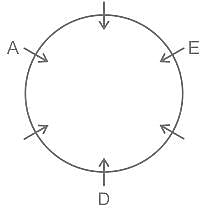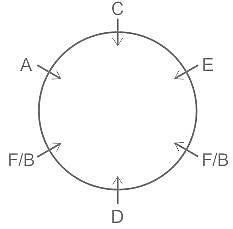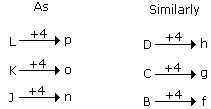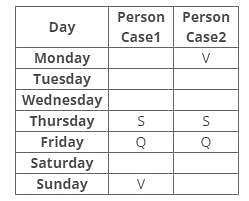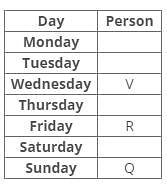BSF Sub Inspector (SI) Mock Test - 4 - BSF SI/ASI MCQ
30 Questions MCQ Test - BSF Sub Inspector (SI) Mock Test - 4
The average weight of A, B and C is 72 kg. When D joins them, the new average becomes 68 kg. When E joins, A, B, C and D, the average of all five becomes 70 kg. What is the weight of E?
The average of 100 numbers is 210. The average of these 100 numbers and 20 other new numbers is 200. What is the average of 20 new numbers?
If the savings of Kalyan is 125% of his expenditure, his expenditure is what percentage of his income?
What is to be subtracted from 81% of 600 so that the answer must be equal to 40% of 300?
A, B, C, D, E and F are sitting in a circle facing towards centre. D is between F and B. A is second to the left of D and second to the right of E. Who is facing towards D?
Directions to Solve
In each of the following questions find out the alternative which will replace the question mark.
Question -
LKJ : pon :: ? : hgf
If $ means +, # means –, @ means × and * means ÷ then what will be the value of 24$3@8#45*5?
Direction: Read the given instructions carefully and answer the questions given beside.
Seven friends P, Q, R, S, T, U and V visits zoo on seven different days of the same week starting from Monday. Who visits the zoo on Sunday?
I. S visits the zoo immediately before Q, who visits on Friday. Two persons visit between S and V.
II. Only two people visits zoo after R. V visits zoo two days before R. Three people visits zoo between V and Q.
Chronologically arrange the following sources in the order they connected through the 'hydrological cycle' (from first to last)
Which institution has launched the ‘Mission 50K-EV4ECO’?
On which day is the International Day for the Elimination of Violence Against Women observed?
What is the rank of India in the Global Intellectual Property Index 2024?
What does Chemical Oxygen Demand (COD) indicate?
What type of radiation is trapped on the earth’s surface by the green house effect ?
The value of the ordinates, at the quarter span of the influence line diagram for the midspan bending moment of a simply supported beam, is 0.5 m. If the span of the beam is doubled, what will be the ordinates at the midspan of the influence line?
In quadrantal bearing system, back bearing of a line may be obtained from its forward bearing, by
When the curvature of earth is taken into account, the surveying is called as
Lateral ties in RC columns are provided to resist-
If two springs of stiffness K1 and K2 are connected in series, the stiffness of the combined spring will be-
The total water consumption, including domestic, commercial and industrial demands for average Indian people is.
The maximum deflection of the cross-sectiontip of a cantilever beam with concentrated load P at the free end is
For an irrigational flow, the velocity potential lines, and the streamlines are always-
The most suitable traffic signal system for mixed traffic condition is-
For determining the ultimate bearing capacity of the soil, the recommended size of the square bearing plate used in the Plate load test is 30-75 cm with a minimum thickness of :
Security deposit deducted at 5% from contractors’ bills is:




